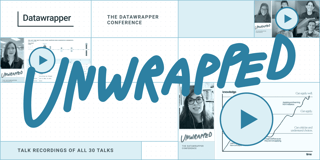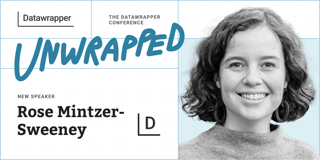Julia Wolfe, Reuters: " It's helped remove a lot of cruft from my team's life"

Julia Wolfe from Reuters spoke at our Unwrapped 2024 conference about "Bringing Datawrapper to your newsroom." From a small newsroom getting the tool for the first time, to a global one with rolling onboarding around the world, she has plenty of experience helping journalists love the tool.
Julia is the editor of the Americas graphics team at Reuters. Before that, she was the senior data visualization editor at FiveThirtyEight, where she retired the internal charting tool for Datawrapper. Previously, she's worked at The Wall Street Journal, The Globe and Mail, and the Toronto Star.
Watch her talk here:
01:11 – My experience with Datawrapper
02:52 – Tips for introducing Datawrapper to a small newsroom
03:03 Build consensus
04:00 Use a project management system
05:04 Think about locking features down
05:54 Show others how to use Datawrapper
06:39 Accept Datawrapper's help
07:42 Tips for using Datawrapper in a big organization
08:25 Internal docs & email templates
09:49 Invest in your acolytes
11:41 Tag team with production
12:49 Automate your charts
13:54 Why use Datawrapper in a newsroom?
15:39 Collaboration
16:46 Q: Maintaining quality when non-graphics people make graphics?
17:42 Q: Reduced quality of visualizations?
19:17 Q: Supervision for non-graphics people?
20:25 Q: Other tools in use?
21:33 Q: Getting non-graphics folks to use Datawrapper?
23:08 Q: Template system?
24:04 Q: Resistance to being told to use Datawrapper?
25:51 Q: Style guide for non-graphics people?
27:04 Q: How fast are journalist when news break?
Here are some soundbites from her talk:
I was first introduced to Datawrapper when I was teaching at the Graduate Journalism School at CUNY, where it was used to teach the students how to make charts for the first time. And it was so exciting. I had seen charting tools before, but it really did democratize charting. Julia Wolfe, Reuters, in minute 1:18 at her talk at Unwrapped 2024
At the risk of sounding like a shill, it's such a good tool that once people use it, the resistance tends to go away. Julia Wolfe, Reuters, in minute 24:46 at her talk at Unwrapped 2024
Why should you bring Datawrapper to your newsroom?
Your graphics team is magic. They have skills that nobody else has. They can code, they can draw, they can map, they can write, they can report, they can do 18 different things. Do not have them spending their time making bar charts.
Because the thing that I believe sets the great graphics teams apart from the good graphics teams is largely determined by how much cruft you keep off their plates.
And so if you can get those daily charts away from them, if you can get maintenance of stuff away from them, if you can turn more reporters to the tool, more automation of the tool, that means your team is doing more original, bespoke graphics journalism that no one else is doing. Julia Wolfe, Reuters, in minute 28:16 at her talk at Unwrapped 2024
We also asked Julia some additional questions:
Why/how did you start using Datawrapper?
I started using Datawrapper as a teacher at CUNY's journalism school. I was awestruck by how easy the tool was for beginners, and how it really lowered the barrier to entry.
What's the Datawrapper chart you're most proud of?
Honestly, I think it's the first Datawrapper chart we published at FiveThirtyEight, appearing in the story We Built A WNBA Prediction Model For The 2021 Season. It was a lot of iterating with the very patient team at Datawrapper to get our styles just right, and it was so exciting to publish a chart that looked like our bespoke style while being completely built in the tool:
What's your guiding principle when working on data visualizations?
The more complex or strange the chart, the clearer the takeaway should be. You can get away with some wild stuff if there's a real "aha" moment for the reader.
And what's your favorite Datawrapper feature?
Small multiple line charts! A new one that's a real game changer.
Thanks to Julia for giving a talk at Unwrapped! Find more about her on LinkedIn , X, and Bluesky.



